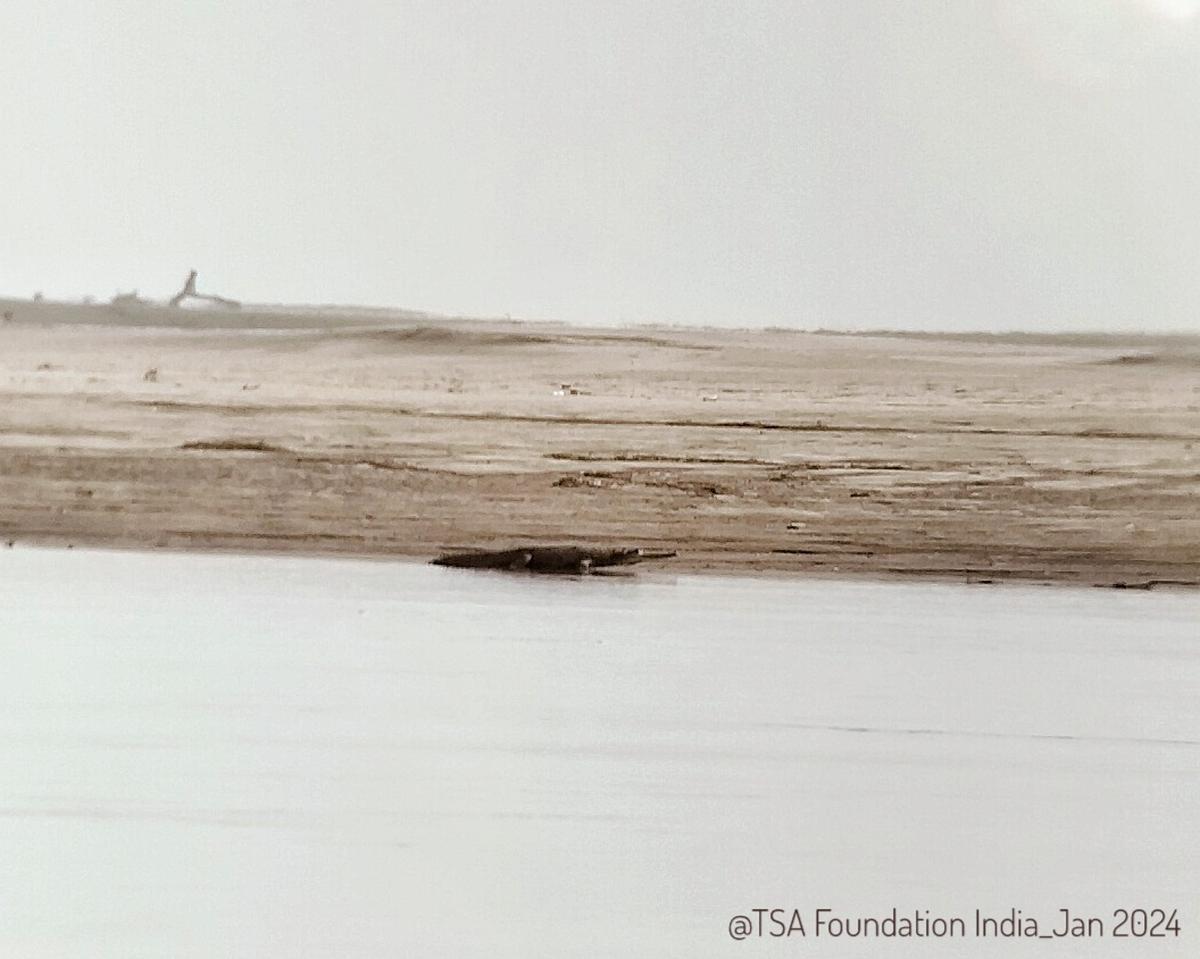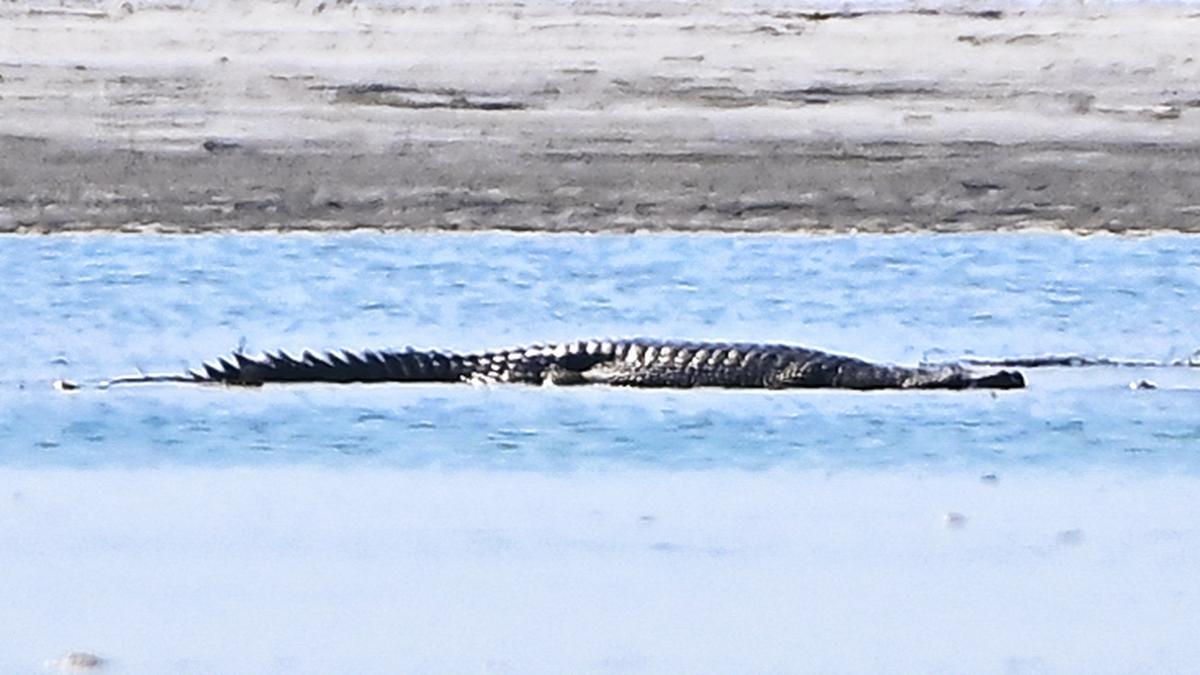A lone female gharial has become the key to repopulating the Brahmaputra river with gharials.
| Photo Credit: Special Arrangement
GUWAHATI
A lone female gharial has temporarily overshadowed the one-horned rhino in eastern Assam’s Kaziranga National Park and Tiger Reserve.
Wildlife officials and specialists are not sure how this gharial came to inhabit a stretch of the Brahmaputra river within the Kaziranga National Park and Tiger Reserve. But they are certain that the reptile, presumed almost an adult by its size, is the key to repopulating the river with gharials.
Distinguished from other crocodilians by its elongated snout, the gharial (Gavialis gangeticus) is believed to have been wiped out from the Brahmaputra river system in the 1950s, although there were claims of sightings in the 1990s.
The female gharial was first spotted in 2021 within the Biswanath Wildlife Division of the 1,307.49 sq. km. Kaziranga. Water bodies, primarily a 107-km stretch of the Brahmaputra, comprise more than 80% of this division measuring 401 sq. km.
The same female gharial, now 2.55 metres in length, was recorded twice basking 500 metres apart in one of the three priority habits chosen during a 10-day survey of aquatic reptiles along the Brahmaputra in January.
Teams of the Turtle Survival Alliance Foundation India (TSAFI), an NGO specialising in reptiles, and the Assam Forest Department surveyed the Brahmaputra in a 160 km stretch from the Kaliabhomora bridge in the west to Majuli’s Kamalabari Ghat beyond the eastern edge of the Biswanath Division.
Survey findings
The survey report submitted to the Forest Department in June said 990 freshwater turtles belonging to five species — Assam roofed turtle, Indian tent turtle, Brown roofed turtle, Indian or Gangetic softshell turtle, and Peacock softshell turtle — and more than 80 other major aquatic faunal species were recorded in the stretch of the Brahmaputra largely within the Biswanath Wildlife Division.
The other aquatic animals included a mammal that shares the gharial’s Ganga connection — the elusive Gangetic river dolphin (Platanista gangetica).

The gharial is believed to have been wiped out from the Brahmaputra river system in the 1950s.
| Photo Credit:
Special Arrangement
The female gharial was found to be the only one of its kind moving between a “sandy shoreline” and a “sand bar with a shoreline water depth of 4.5 metres”.
According to the Wildlife Institute of India, gharials were widely distributed in the Brahmaputra, Ganga, Indus, and the Mahanadi-Brahmani-Baitarani river systems of India, Bhutan, Bangladesh, Nepal, and Pakistan. Today, their major populations occur in three tributaries of the Ganga — the Chambal and Girwa in India, and the Rapti-Narayani river in Nepal.
“Female gharials are identified by the absence of the ghara (resembling an earthen pot) on the tip of the snout of the males. We do not know much about gharials in the Brahmaputra but we do know that this female has been lonely for more than three years and is close to the size of an adult ready to breed,” Sushmita Kar, TSAFI’s project director in the northeast, told The Hindu.
Reintroduction proposal
One of the 10 recommendations in the report was the “high-priority” reintroduction of gharials in the Brahmaputra landscape, especially within the Biswanath Division, considering the “suitability of habitats in supporting the survival of this species in the long run”.
Kaziranga’s Director Sonali Ghosh agreed the tiger reserve has the right conditions for a gharial breeding programme. “There is no anthropogenic pressure in the Brahmaputra within Biswanath Division because fishing is banned in this stretch. This will ensure food for the gharials that largely depend on fish,” she said.
“Unlike Chambal or other northern Indian rivers, the Brahmaputra is flood-prone. This female gharial withstood at least three floods, indicating gharials — preferably juveniles and sub-adults for faster acclimatisation — can survive in the Brahmaputra and its channels,” Ms. Kar said.
If the reintroduction proposal is approved, the reptiles are likely to be brought from the Kukrail gharial breeding centre near Lucknow in Uttar Pradesh.






